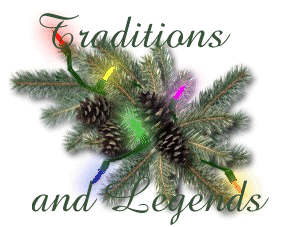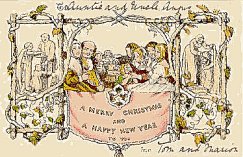
Did you know that many of the symbols and ways we celebrate Christmas were derived from ancient legends? Following are some of the histories behind these traditions and legends. (Please note that with the exception of "Christmas" and "Christmas Cards", I have not included those which were adopted from England as these are shown in the "Dickens Christmas" part of the segment. To learn about these, go to "A Dickens Christmas".
The Advent Calendar
![]() The advent calendar actually originated in Germany and Scandinavia. Sometimes it is shown as the picture of a house with windows that can be opened to reveal tiny pictures behind them. Other times it is a Christmas landscape with perforated areas that can be removed or opened to reveal the pictures behind them. There is one window or flap for each day of Advent which is the season before Christmas. Each day children are allowed to open one of the windows which usually features a picture of a toy or Christmas scene. The last picture which is the largest is the nativity which is what the Christmas season is all about. (Don't forget to visit our Advent Calendar.)
The advent calendar actually originated in Germany and Scandinavia. Sometimes it is shown as the picture of a house with windows that can be opened to reveal tiny pictures behind them. Other times it is a Christmas landscape with perforated areas that can be removed or opened to reveal the pictures behind them. There is one window or flap for each day of Advent which is the season before Christmas. Each day children are allowed to open one of the windows which usually features a picture of a toy or Christmas scene. The last picture which is the largest is the nativity which is what the Christmas season is all about. (Don't forget to visit our Advent Calendar.)
Candlemas
![]() The tradition known as Candlemas Day which derived from the pagan celebration of Imbolc was brought to the United States during the 1700s by German settlers. It was believed that if it was a sunny day, there would be forty more days of winter. This belief was carried into American folklore as Groundhog Day which is also celebrated on February 2.
The tradition known as Candlemas Day which derived from the pagan celebration of Imbolc was brought to the United States during the 1700s by German settlers. It was believed that if it was a sunny day, there would be forty more days of winter. This belief was carried into American folklore as Groundhog Day which is also celebrated on February 2.
Candlemas also has a religious significance. It is the celebration of the purification of Mary as required by Jewish law and which took place forty days after the birth of her child. It is celebrated on February 2 and is considered the end of the Christmas season. It was a custom of early Christian clergy to bless candles and distribute them to the people in the dark of winter.
The Candy Cane

![]() The candy cane goes back over 350 years when candy makers created the candy in pure white sticks. The first historical reference to the candy cane in his "hooked" (shepard's hook) shape dates back to 1670 when the choirmaster at a German cathedral bent the all white candy and gave it to the children to keep them quiet during the long Christmas service. This practice spread both throughout Europe and later in America around 1847. It was said that a German immigrant, August Imgard decorated his Christmas tree in his Wooster, Ohio home with the white, sugary candy.
The candy cane goes back over 350 years when candy makers created the candy in pure white sticks. The first historical reference to the candy cane in his "hooked" (shepard's hook) shape dates back to 1670 when the choirmaster at a German cathedral bent the all white candy and gave it to the children to keep them quiet during the long Christmas service. This practice spread both throughout Europe and later in America around 1847. It was said that a German immigrant, August Imgard decorated his Christmas tree in his Wooster, Ohio home with the white, sugary candy.
The red and white stripes were added to the candy approximately 50 years later. No one is certain as to who person was who had done so, but there is a story that has been passed along that the candy cane, originally called the "Christmas candy" was created by a candymaker in Indiana who wanted to make a candy that symbolized the birth, ministry and death of Jesus. He used a stick of pure white hard candy to symbolize the virgin birth and the sinless nature of Christ. Its hardness represented the foundation of the church and the firmness of the promises of God. He shaped it in the form of the letter "J" to represent Jesus' name. He then stained the candy with red stripes to show the scourging Jesus received. The large red stripe is for the blood shed by Christ. It later lost its symbolic meaning when it became known as a candy cane. It was about then that candy makers began to add the flavor of peppermint to the sweet treat. Today, you'll find candy canes striped in various colors and in various flavors.
Christmas
![]() The name Christmas comes from the old English cristes maesse (Christ's Mass). The traditional Christmas celebration was not a single day but a period of 12 days which included December 24th through January 6.
The name Christmas comes from the old English cristes maesse (Christ's Mass). The traditional Christmas celebration was not a single day but a period of 12 days which included December 24th through January 6.
Christmas Cards

![]() The first Christmas card is credited to Sir Henry Cole and J. C. Horsley in England in 1843. In 1875, Louis Prang, a German-born printer, printed the first American cards in 1875 in his shop in Roxbury, Massachusetts. He promoted the cards by establishing nation-wide contests for the best holiday designs and awarded cash prizes.
The first Christmas card is credited to Sir Henry Cole and J. C. Horsley in England in 1843. In 1875, Louis Prang, a German-born printer, printed the first American cards in 1875 in his shop in Roxbury, Massachusetts. He promoted the cards by establishing nation-wide contests for the best holiday designs and awarded cash prizes.
